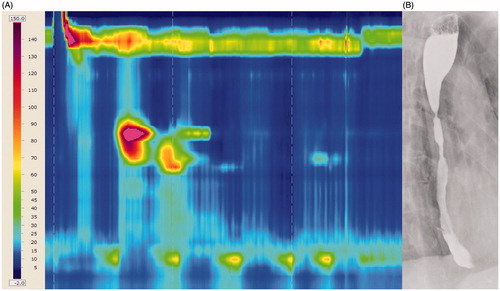Figures & data
Figure 1. High-resolution manometry (A) and barium esophagogram (B) before treatment. The high-resolution manometry (HRM) shows simultaneous, hypertensive and distally repetitive contractions after a swallow with a normal LES relaxation (integrated relaxation pressure (IRP) of 8.3 mmHg) and distal latency of three seconds typical for DES. On the barium esophagogram tertiary, spastic contractions are seen, resembling a corkscrew and passage of barium contrast is delayed.

Figure 2. Radiograph with water-soluble contrast one day after POEM procedure. It demonstrates a stenosis proximal of the incision with a prestenotic dilation which is attributed to edema and spasm and caused severe dysphagia for the patient.

Figure 3. High-resolution manometry (A) and barium esophagogram (B) three months after POEM procedure. Proximal to the myotomy a small segment with hypertensive and spastic contractions is still present on the high-resolution manometry. The barium esophagogram confirms this by showing a proximal prestenotic dilation. These findings explain the cause of high dysphagia the patient still experienced after treatment.

